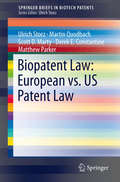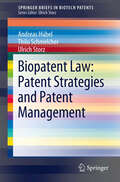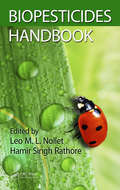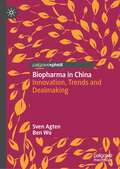- Table View
- List View
Biopacemaking (Series in Biomedical Engineering)
by J. A. E Spaan Ruben Coronel Jacques M. T. De Bakker Antonio ZazaThe development of a bio-engineered pacemaker is of substantial clinical and also scientific interest because it promises to overcome several limitations of electronic pacemakers. Moreover it may answer the longstanding question of whether the complex structure of the sinus node is indeed a prerequisite for reliable pacemaking, or simpler structures might work as well. This book gives an overview of the current state-of-the-art of creating a bio-engineered pacemaker. It shows the approaches to develop of genetic and cell-based engineering methods suitable to implement them with safety and stability. It also illuminates the problems that need to be solved before bio-pacemaking can be considered for clinical use.
Biopackaging
by Martin A. MasuelliThis book examines the whole range of modern packaging options. It covers edible packaging based on carbohydrates, proteins, antioxidative and antimicrobial packaging, and the chemistry of food and food packaging, such as plasticization and polymer morphology. Issues related to shelf life and biodegradability are also discussed, in addition to newly discovered processing and preservation techniques, most notably modified atmosphere packaging (MAP) and active packaging (AP).
Biopackaging
by Martin Alberto MasuelliThis book examines the whole range of modern packaging options. It covers edible packaging based on carbohydrates, proteins, antioxidative and antimicrobial packaging, and the chemistry of food and food packaging, such as plasticization and polymer morphology. Issues related to shelf life and biodegradability are also discussed, in addition to newly discovered processing and preservation techniques, most notably modified atmosphere packaging (MAP) and active packaging (AP).
Biopatent Law: European Patent Law Vs. Us Patent Law (SpringerBriefs in Biotech Patents)
by Ulrich Storz Martin Quodbach Scott D. Marty Derek E. Constantine Matthew ParkerSpringerBriefs in Biotech Patents presents timely reports on intellectual properties (IP) issues and patent aspects in the field of biotechnology. This volume focus on particular aspects of the US patent law, which can have tremendous differences compared to the European law. This includes questions of biopatent prosecution, novelty, inventive step, written disclosure and sufficiency of enablement as well as questions of law enforcement of biotech patents.
Biopatent Law: Patent Strategies and Patent Management (SpringerBriefs in Biotech Patents)
by Andreas Hübel Thilo Schmelcher Ulrich StorzPatents protecting biotechnological invention are becoming ever more important. Because biotechnology has many differences with respect to other technologies, lessons learned in other fields of technology cannot simply be transferred to adopt a suitable strategy for dealing with biotechnology inventions. In this volume, general aspects of biopatent law will be discussed. This involves questions of patentability, including ethical issues and issues of technicality, as well as questions of patent exhaustion in cases were reproducible subject matter, like cells or seeds, is protected. Moreover, active and passive patent strategies are addressed. Further, insight will be given into patent lifetime management and additional protective measures, like supplementary protection certificates and data exclusivity. Here, strategies are discussed how market exclusivity can be extended as long as possible, which is particularly important for biopharmaceutical drugs, which create high R&D costs.
Biopesticides: Use and Delivery (Methods in Biotechnology #5)
by Franklin R. Hall and Julius J. MennBiopesticides and Bioagents: Novel Tools for Pest Management
by Arshad AnwerInsects, diseases, and weeds cause an almost 30% yield loss per annum in agricultural production, resulting in an increased consumption of pesticides by 20% per annum throughout the world. This comprehensive volume looks at the status of biopesticides and biocontrol agents in agriculture. It will be a critically important reference work, providing basic facts and studies on new and current discoveries of the role of biopesticides and bioagents in integrated pest management (IPM). The book contains four main sections, covering the status of biopesticides and biocontrol agents in agriculture plant health-promoting biocontrol agents parasitoids and predators genetically modified crops and Bacillus thuringiensis, and phytochemicals in biocontrol The volume provides information regarding new advances in microbial, biochemical, and genetically modified and organic nanoparticles in integrated pest management. Biopesticides and Bioagents: Novel Tools for Pest Management should find a prominent place on the shelves of agriculture and plant scientists, microbiologists, biotechnologists, plant pathologists and entomologists working in academic and commercial agrichemical situations, and in the libraries of all research establishments and companies where this exciting subject is researched, studied, or taught.
Biopesticides and Bioagents: Novel Tools for Pest Management
by Md. Arshad AnwerInsects, diseases, and weeds cause an almost 30% yield loss per annum in agricultural production, resulting in an increased consumption of pesticides by 20% per annum throughout the world. This comprehensive volume looks at the status of biopesticides and biocontrol agents in agriculture. It will be a critically important reference work, providing basic facts and studies on new and current discoveries of the role of biopesticides and bioagents in integrated pest management (IPM). The book contains four main sections, covering the status of biopesticides and biocontrol agents in agriculture plant health-promoting biocontrol agents parasitoids and predators genetically modified crops and Bacillus thuringiensis, and phytochemicals in biocontrol The volume provides information regarding new advances in microbial, biochemical, and genetically modified and organic nanoparticles in integrated pest management. Biopesticides and Bioagents: Novel Tools for Pest Management should find a prominent place on the shelves of agriculture and plant scientists, microbiologists, biotechnologists, plant pathologists and entomologists working in academic and commercial agrichemical situations, and in the libraries of all research establishments and companies where this exciting subject is researched, studied, or taught.
Biopesticides Handbook
by Leo M.L. Nollet Showkat Rasool MirBiopesticides have a great influence in sustainable agriculture, and their use in commercial farming ensures environmental protection, qualitative products, and effective use of resources. The second edition of Biopesticides Handbook is fully updated and includes five new chapters on microbial, biochemical, and RNAi pesticides. It details the benefits of biopesticides along the food chain, offering a full spectrum of the range of organisms and organic products that may be used in the biological control of pests. It discusses the uses and abuses of biopesticides, their positive and negative consequences, as well as more recent advances and the best mode of action to improve environmental safety.FEATURES Thoroughly updated, this edition explores not only the benefits but also all aspects of biopesticides Includes new chapters on the uses of biochemical and microbial pesticides and plant-incorporated protectants Discusses the new field of RNAi pesticides Provides information on insect growth regulators and allelochemicals Introduces a new chapter on the uses of biopesticides in food and medicinal crops This book is intended for professionals, researchers, academics, and postgraduate students with experience in fields such as chemistry, biochemistry, environmental sciences, ecology, and agriculture, as well as those invested in the supply chain of agricultural products, such as farmers, growers, and other stakeholders.
Biopesticides Handbook
by Leo M. L. Nollet Hamir Singh RathoreThe need to feed an ever-growing global population combined with increasing demand for sustainable agricultural practices has generated a significant rise in demand for biopesticides. By responding concurrently to the interests of farming, forestry, and industrial sectors, biopesticides offer a considerable potential for utilization in sustainable
Biopesticides Handbook
by Leo M. L. Nollet Hamir Singh RathoreThe need to feed an ever-growing global population combined with increasing demand for sustainable agricultural practices has generated a significant rise in demand for biopesticides. By responding concurrently to the interests of farming, forestry, and industrial sectors, biopesticides offer a considerable potential for utilization in sustainable
Biopesticides Handbook
Biopesticides have a great influence in sustainable agriculture, and their use in commercial farming ensures environmental protection, qualitative products, and effective use of resources. The second edition of Biopesticides Handbook is fully updated and includes five new chapters on microbial, biochemical, and RNAi pesticides. It details the benefits of biopesticides along the food chain, offering a full spectrum of the range of organisms and organic products that may be used in the biological control of pests. It discusses the uses and abuses of biopesticides, their positive and negative consequences, as well as more recent advances and the best mode of action to improve environmental safety.FEATURES Thoroughly updated, this edition explores not only the benefits but also all aspects of biopesticides Includes new chapters on the uses of biochemical and microbial pesticides and plant-incorporated protectants Discusses the new field of RNAi pesticides Provides information on insect growth regulators and allelochemicals Introduces a new chapter on the uses of biopesticides in food and medicinal crops This book is intended for professionals, researchers, academics, and postgraduate students with experience in fields such as chemistry, biochemistry, environmental sciences, ecology, and agriculture, as well as those invested in the supply chain of agricultural products, such as farmers, growers, and other stakeholders.
Biopesticides in Horticultural Crops
by Rajeshwari R. Vikram AppannaThis book is a compendium of information related to innovations, commercialization and registration of biopesticides, recent advances in mass production, formulation, extension of shelf life, delivery systems of antagonists and entomopathogens and synergistic and antagonistic response of biopesticides with agrochemicals. The information on all the important laboratory protocols and techniques in isolation, identification, selection, culturing, mass production, formulation, enhancement of shelf life and biosafety issues of bioinoculants used as biopesticides in horticulture crops have been included for the benefit of research scientists, teachers, research scholars and students working in the field of biopesticides.Note: T&F does not sell or distribute the hardback in India, Pakistan, Nepal, Bhutan, Bangladesh and Sri Lanka.
Biopesticides in Horticultural Crops
by Rajeshwari R. Vikram AppannaThis book is a compendium of information related to innovations, commercialization and registration of biopesticides, recent advances in mass production, formulation, extension of shelf life, delivery systems of antagonists and entomopathogens and synergistic and antagonistic response of biopesticides with agrochemicals. The information on all the important laboratory protocols and techniques in isolation, identification, selection, culturing, mass production, formulation, enhancement of shelf life and biosafety issues of bioinoculants used as biopesticides in horticulture crops have been included for the benefit of research scientists, teachers, research scholars and students working in the field of biopesticides.Note: T&F does not sell or distribute the hardback in India, Pakistan, Nepal, Bhutan, Bangladesh and Sri Lanka.
Biopesticides in Organic Farming: Recent Advances
by L. P. AwasthiThe book entitled "Biopesticides in Organic Farming : Recent Advances", describes critically reviewed, key aspects of organic farming and provides a unique and timely science-based resource for researchers, teachers, extension workers, students, primary producers and others around the world. This book is intended to be a unique and indispensable resource that offers a diverse range of valuable information and perspectives on biopesticides in organic agriculture. It has chapters on each and every aspect related with biopesticides in organic farming which are compiled by researchers and eminent professors at various universities across the globe. The wide spectrum information in various chapters with the addition of the terms related to organic farming and concept statements is presented in very concise manner. Features: This book is designed, as per course curriculum of different universities offering courses on Organic Farming, for undergraduate and post graduate students, researchers, university professors and extension workers. The first section provides, Overview of organic farming with special reference to biopesticides followed by the Principles of the applications of biopesticides in organic farming, Impact of Environmental factors on biopesticides in organic farming, Pesticides Exposure Impacts on Health and Need of Biopesticides in Organic Farming, and Role of nutrients in the management of crop diseases through biopesticides. The next section deals with the management of various crop diseases through biopesticides of bacterial, fungal, viral, and Insect sex hormone, Natural enemies and Integrated Pest Management, Biotechnological Trends in Insect Pests Control Strategy, Challenges in the popularization of Biopesticides in organic farming, Certification process and standards of organic farming and Marketing and export potential of organic Products. Information presented in an accessible way for students, professors, researchers, business innovators and entrepreneurs, management professionals and practitioners.
Biopesticides in Organic Farming: Recent Advances
by L. P. AwasthiThe book entitled "Biopesticides in Organic Farming : Recent Advances", describes critically reviewed, key aspects of organic farming and provides a unique and timely science-based resource for researchers, teachers, extension workers, students, primary producers and others around the world. This book is intended to be a unique and indispensable resource that offers a diverse range of valuable information and perspectives on biopesticides in organic agriculture. It has chapters on each and every aspect related with biopesticides in organic farming which are compiled by researchers and eminent professors at various universities across the globe. The wide spectrum information in various chapters with the addition of the terms related to organic farming and concept statements is presented in very concise manner. Features: This book is designed, as per course curriculum of different universities offering courses on Organic Farming, for undergraduate and post graduate students, researchers, university professors and extension workers. The first section provides, Overview of organic farming with special reference to biopesticides followed by the Principles of the applications of biopesticides in organic farming, Impact of Environmental factors on biopesticides in organic farming, Pesticides Exposure Impacts on Health and Need of Biopesticides in Organic Farming, and Role of nutrients in the management of crop diseases through biopesticides. The next section deals with the management of various crop diseases through biopesticides of bacterial, fungal, viral, and Insect sex hormone, Natural enemies and Integrated Pest Management, Biotechnological Trends in Insect Pests Control Strategy, Challenges in the popularization of Biopesticides in organic farming, Certification process and standards of organic farming and Marketing and export potential of organic Products. Information presented in an accessible way for students, professors, researchers, business innovators and entrepreneurs, management professionals and practitioners.
Biopesticides Manual: Guidelines for Selecting, Sourcing, Producing and Using Biopesticides for Key Pests of Tobacco
by Keith A Holmes Dirk Babendreier Melanie Bateman Malvika Chaudhary Julien Grunder Margaret Mulaa Léna Durocher-Granger Muhammad FaheemThe Biopesticides Manual provides information resources and technical advice in order to support the deployment of biopesticides. It is a one-stop-shop to address the information needs of the key groups who are responsible for selecting, sourcing and using biopesticides in the tobacco production system. Biopesticides are a key component of integrated pest management (IPM) in tobacco. IPM seeks to reduce the risk of harm to people and the environment. When used in conjunction with good crop management, biopesticides can help to keep pest levels under control, reducing the need to apply conventional pesticides.
Biopharma in China: Innovation, Trends and Dealmaking
by Sven Agten Ben WuThis book provides an insider’s overview of the emerging Chinese biopharma sector, its dynamics and trends, first bust and boom cycle, long-term perspectives, and how as a foreign company or investor to tap into this. China has gone from a country with no innovation in drug discovery, to a country which starts to out-license its biopharma technology to the rest of the world. The Chinese biopharma sector is only a decade old, but it already has become a new driver of growth and value. The book takes a closer look at what drives Chinese innovation in the biopharma sector, how to deal with this innovation, and what opportunities and challenges this provides for foreign companies. The book also takes a deep dive into its first biopharma boom and bust cycle, and what it means for the sector. It also explains what deals Chinese biopharma companies and investors are looking for, what works and what doesn’t, and how as a foreign company can tap into the world’s second largest healthcare market.
Biopharmaceutical Applied Statistics Symposium: Volume 2 Biostatistical Analysis of Clinical Trials (ICSA Book Series in Statistics)
by Karl E. Peace Ding-Geng Chen Sandeep MenonThis BASS book Series publishes selected high-quality papers reflecting recent advances in the design and biostatistical analysis of biopharmaceutical experiments – particularly biopharmaceutical clinical trials. The papers were selected from invited presentations at the Biopharmaceutical Applied Statistics Symposium (BASS), which was founded by the first Editor in 1994 and has since become the premier international conference in biopharmaceutical statistics. The primary aims of the BASS are: 1) to raise funding to support graduate students in biostatistics programs, and 2) to provide an opportunity for professionals engaged in pharmaceutical drug research and development to share insights into solving the problems they encounter.The BASS book series is initially divided into three volumes addressing: 1) Design of Clinical Trials; 2) Biostatistical Analysis of Clinical Trials; and 3) Pharmaceutical Applications. This book is the second of the 3-volume book series. The topics covered include: Statistical Approaches to the Meta-analysis of Randomized Clinical Trials, Collaborative Targeted Maximum Likelihood Estimation to Assess Causal Effects in Observational Studies, Generalized Tests in Clinical Trials, Discrete Time-to-event and Score-based Methods with Application to Composite Endpoint for Assessing Evidence of Disease Activity-Free , Imputing Missing Data Using a Surrogate Biomarker: Analyzing the Incidence of Endometrial Hyperplasia, Selected Statistical Issues in Patient-reported Outcomes, Network Meta-analysis, Detecting Safety Signals Among Adverse Events in Clinical Trials, Applied Meta-analysis Using R, Treatment of Missing Data in Comparative Effectiveness Research, Causal Estimands: A Common Language for Missing Data, Bayesian Subgroup Analysis with Examples, Statistical Methods in Diagnostic Devices, A Question-Based Approach to the Analysis of Safety Data, Analysis of Two-stage Adaptive Seamless Trial Design, and Multiplicity Problems in Clinical Trials – A Regulatory Perspective.
Biopharmaceutical Applied Statistics Symposium: Volume 1 Design of Clinical Trials (ICSA Book Series in Statistics)
by Karl E. Peace Ding-Geng Chen Sandeep MenonThis BASS book Series publishes selected high-quality papers reflecting recent advances in the design and biostatistical analysis of biopharmaceutical experiments – particularly biopharmaceutical clinical trials. The papers were selected from invited presentations at the Biopharmaceutical Applied Statistics Symposium (BASS), which was founded by the first Editor in 1994 and has since become the premier international conference in biopharmaceutical statistics. The primary aims of the BASS are: 1) to raise funding to support graduate students in biostatistics programs, and 2) to provide an opportunity for professionals engaged in pharmaceutical drug research and development to share insights into solving the problems they encounter.The BASS book series is initially divided into three volumes addressing: 1) Design of Clinical Trials; 2) Biostatistical Analysis of Clinical Trials; and 3) Pharmaceutical Applications. This book is the first of the 3-volume book series. The topics covered include: A Statistical Approach to Clinical Trial Simulations, Comparison of Statistical Analysis Methods Using Modeling and Simulation for Optimal Protocol Design, Adaptive Trial Design in Clinical Research, Best Practices and Recommendations for Trial Simulations in the Context of Designing Adaptive Clinical Trials, Designing and Analyzing Recurrent Event Data Trials, Bayesian Methodologies for Response-Adaptive Allocation, Addressing High Placebo Response in Neuroscience Clinical Trials, Phase I Cancer Clinical Trial Design: Single and Combination Agents, Sample Size and Power for the Mixed Linear Model, Crossover Designs in Clinical Trials, Data Monitoring: Structure for Clinical Trials and Sequential Monitoring Procedures, Design and Data Analysis for Multiregional Clinical Trials – Theory and Practice, Adaptive Group-Sequential Multi-regional Outcome Studies in Vaccines, Development and Validation of Patient-reported Outcomes, Interim Analysis of Survival Trials: Group Sequential Analyses, and Conditional Power – A Non-proportional Hazards Perspective.
Biopharmaceutical Applied Statistics Symposium: Volume 3 Pharmaceutical Applications (ICSA Book Series in Statistics)
by Karl E. Peace Ding-Geng Chen Sandeep MenonThis BASS book Series publishes selected high-quality papers reflecting recent advances in the design and biostatistical analysis of biopharmaceutical experiments – particularly biopharmaceutical clinical trials. The papers were selected from invited presentations at the Biopharmaceutical Applied Statistics Symposium (BASS), which was founded by the first Editor in 1994 and has since become the premier international conference in biopharmaceutical statistics. The primary aims of the BASS are: 1) to raise funding to support graduate students in biostatistics programs, and 2) to provide an opportunity for professionals engaged in pharmaceutical drug research and development to share insights into solving the problems they encounter.The BASS book series is initially divided into three volumes addressing: 1) Design of Clinical Trials; 2) Biostatistical Analysis of Clinical Trials; and 3) Pharmaceutical Applications. This book is the third of the 3-volume book series. The topics covered include: Targeted Learning of Optimal Individualized Treatment Rules under Cost Constraints, Uses of Mixture Normal Distribution in Genomics and Otherwise, Personalized Medicine – Design Considerations, Adaptive Biomarker Subpopulation and Tumor Type Selection in Phase III Oncology Trials, High Dimensional Data in Genomics; Synergy or Additivity - The Importance of Defining the Primary Endpoint, Full Bayesian Adaptive Dose Finding Using Toxicity Probability Interval (TPI), Alpha-recycling for the Analyses of Primary and Secondary Endpoints of Clinical Trials, Expanded Interpretations of Results of Carcinogenicity Studies of Pharmaceuticals, Randomized Clinical Trials for Orphan Drug Development, Mediation Modeling in Randomized Trials with Non-normal Outcome Variables, Statistical Considerations in Using Images in Clinical Trials, Interesting Applications over 30 Years of Consulting, Uncovering Fraud, Misconduct and Other Data Quality Issues in Clinical Trials, Development and Evaluation of High Dimensional Prognostic Models, and Design and Analysis of Biosimilar Studies.
Biopharmaceutical Drug Design and Development
by Susanna Wu-Pong Yon RojanasakulThis book provides a comprehensive examination of the newest biopharmaceutical drugs. Among the drugs discussed are ones in the categories of monoclonal antibodies for in-vivo use, cytokines, growth factors, enzymes, immunomodulators, thrombolytics, and immonotherapies including vaccines. Additionally, the volume examines new and emerging technologies, and contains a review of the Human Genome Project.
Biopharmaceutical Drug Design and Development
by YongyutRojanasakul SusannaWu-PongNew discoveries in biology are occurring at an incredible rate, and with these discoveries arise nearly unimaginable opportunities in every area of human existence. Imagine the excitement surround ing the "penicillin project" and the subsequent rapid development of anti-infective agents that took place in the 1940s and 1950s. Fast for ward to the world today and our ability to treat life-threatening infec tions. This is but one small piece in the present kaleidoscope of new therapeutic agents. In fact, the world of science, biology, and medi cine is changing so quickly that it is difficult for scientists and medi cal practitioners to stay abreast of their fields and confidently anticipate that their education and training will sustain them over a three- to four-decade career without considerable continuing educa tion and training. For the pharmaceutical scientist responsible for the discovery and development of therapeutic agents based on advances in biotechnology, it is imperative to quickly come up to speed and stay at the forefront of developments, which is no easy task for those not specifically trained in this area. Biopharmaceutical Drug Design and Development, edited by Susanna Wu-Pong and Yongyut Rojanasakul, cuts a potentially wide swath in terms of its intended audience. It clearly is a primer for those not trained in the area, or for those who wish to be brought into the mainstream of drug discovery and development in the world of bio technology.
Biopharmaceutical Manufacturing: Progress, Trends and Challenges (Cell Engineering #11)
by Ralf PörtnerThis volume “Cell Engineerring 11 - Biopharmaceutical Manufacturing: Progress, Trends and Challenges” is a source of the latest innovative research and technical development in biomanufacturing systems. It is organised into 2 parts: 1) Manufacturing of recombinant therapeutic proteins (e.g. therapeutic antibodies, biosimilars/biogenerics) and 2) Manufacturing aspects of cell and gene therapy. Each with selected chapters on the following topics for both up- and downstream, such as: Advanced process strategies, especially continuous manufacturing, Advanced culture techniques, especially single-use systems, Process transfer, scale-up/scale-down models, Processing advances/Manufacturing productivity/efficiency, Model-assisted process understanding and development/Digital Twins, Process controls and analytics, Quality control, Quality by design, Facility design and full-scale commercial systems, manufacturing technology innovation.The book comprises contributions of experts from academia and industry active in the field of cell culture development for the production of recombinant proteins, cell therapy and gene therapy, with consideration of Digital Twin´s and facility design. The knowledge and expertise of the authors cover disciplines like cell biology, engineering, biotechnology and biomedical sciences. Inevitably, some omissions will occur in the test, but the authors have sought to avoid duplications by extensive cross-referencing to chapters in other volumes of this series and elsewhere. We hope the volume provides a useful compendium of techniques for scientists in industrial and research laboratories active in this field.


















